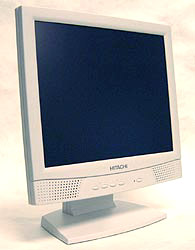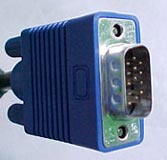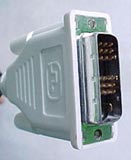Hitachi CML153XW 15-inch TFT Display
The overall
high cost of mainstream LCD displays has brought about a surge in
lower-priced value displays, products which typically lack many bells and whistles, but offer decent quality. Given that the most expensive component in any display is the LCD glass panel itself, it is the main area where cost reductions occur, and that translates directly into how well you view things.
Chances are
high that you won't notice most of the reasons why one panel might happen to be
value over that of another that would be considered high end unless you
specifically look for them, or have
a higher end model to directly compare against. The CML153XW we are looking at
today from Hitachi Displays is a 15" TFT LCD intended for the value market and is quite
inexpensive all things considered. It retails for about $370 and boasts a very
thin panel that measures 1" thick. The CML153XW display combines some great multimedia
features with an average overall display quality.
The CML153XW is a 15"
display capable of 1024x768 resolutions that can be removed from the one-axis
tilting stand and mounted on a 75mm VESA armature for a zero desktop footprint.
With integrated stereo speakers (2" diameter), volume wheel and head phone jack
the display enables users to listen to music from their computer with ease, and
without reaching around behind the system to get at jacks. The LCD panel uses an
anti reflective coating to improve visibility and the entire unit can be secured
by the Kensington Security Port on the rear of the panel housing.
|
Hitachi CML153XW Display: |
 |
15" Diagonal Viewable Size (a-si TFT active matrix display)
Dot pitch: 0.297mm
Contrast Ratio: 300:1
Luminance: 200cd/m2
Viewing Angles: 45/45/60/60 (up/down/left/right)
Consumes 25 Watts power
1280x1024 pixel resolution, analog video connection only
Weighs approx.: 8lbs
External universal power supply (100-240 Volt AC)
Comes with: 6 foot power cord, 15-pin D-sub
analog video cable, AC-adaptor, audio cable.
Manufacturer: Hitachi |
| lcd display
comparisons |
| display |
pixel pitch |
luminance |
contrast |
viewing angle |
screen size |
max resolution |
price range |
| AOC
LM-500 |
0.270 mm |
200 cd/m2
|
150:1
|
50/50/40/40 |
15" |
1024 x 768 |
$350 |
| Hitachi CML153XW
|
0.297 mm |
200 cd/m2 |
300:1 |
45/45/60/60 |
15" |
1024 x 768 |
$400 |
| Hitachi
CML151XW |
0.297 mm |
200 cd/m2 |
350:1 |
45/55/60/60 |
15" |
1024 x 768 |
$420 |
| Samsung
150MP |
0.297 mm |
200 cd/m2 |
300:1 |
70/70/60/60 |
15" |
1024 x 768 |
$650 |
| Samsung
150T |
0.297 mm |
200 cd/m2 |
300:1 |
60/60/55/55 |
15" |
1024 x 768 |
$600 |
| Samsung
570S |
0.297 mm |
200 cd/m2 |
250:1 |
60/60/55/55 |
15" |
1024 x 768 |
$500 |
| Samsung
570V |
0.297 mm |
200 cd/m2 |
250:1 |
60/60/55/55 |
15" |
1024 x 768 |
$400 |
|
|
|
|
|
|
|
|
| Samsung
170MP |
0.264 mm |
170 cd/m2 |
220:1 |
80/80/80/80 |
17" |
1280 x 1024 |
$1000 |
| Samsung
170T |
0.281 mm |
220 cd/m2 |
350:1 |
80/80/80/80 |
17" |
1280 x 1024 |
$900 |
|
|
|
|
|
|
|
|
| Samsung
180T |
0.280 mm |
220 cd/m2 |
350:1 |
80/80/80/80 |
18.1" |
1280 x 1024 |
$1600 |
| Samsung
800TFT |
0.2805 mm |
170 cd/m2 |
220:1 |
80/80/80/80 |
18.1" |
1280 x 1024 |
$2500 |
|
|
|
|
up/down/left/right |
|
|
(USD) |
Important info about buying a TFT
display
We always suggest you test any flat panel
display you are considering in the store before you pay for it!
LCD panels are very complex components
and in the past many manufacturers only guaranteed their display's to be 99.9%
free from defect. That could mean up to 3 or 5 broken pixels before the display
is considered "broken." Broken pixels are individual pixels in the display panel
which are stuck on a certain colour, are constantly dim, or are always off.
Depending on the location and intensity of a broken pixel they can be next to
invisible, or glaringly obvious. It pays to test the display first, regardless
of which manufacturer makes it.
Analog and DVI Standards
| Analog Connection |
DVI Connection |
 |
 |
Analog video connections are the type of video cable most commonly in use at the moment. In the future this may change, but for the moment there are still a heck of a lot of people holding on to their old 17" CRT displays so there isn't much incentive for video card manufacturers to drop this standard just yet. When the price of LCD's comes down to the sub $400 level I would expect DVI to become more dominant.
The basic differences between an analog display adapter and a DVI (digital) display adapter (besides the blue and white colors) is that with the blue analog cable the image is transmitted to your monitor as an analog signal. On the other it arrives at the display as a digital stream of one's and zero's. When these display signals are sent to an LCD display - a device which only operates in the digital realm - the picture must translated to a digitally signal before it can be processed and displayed. On the other hand, if you happen to be equipped with a digital output on your video card, the digital signals are simply sent right to the display to be shown on the screen as they were intended.
Is there a difference between the two means of connecting a display? No... not really. On the visual level there hasn't ever been a perceivable difference in display quality that I could
actually see. The CML153XW only uses an Analog connector, and the cable that ships with the unit seem thinner than most normal displays use no that I think about it.

